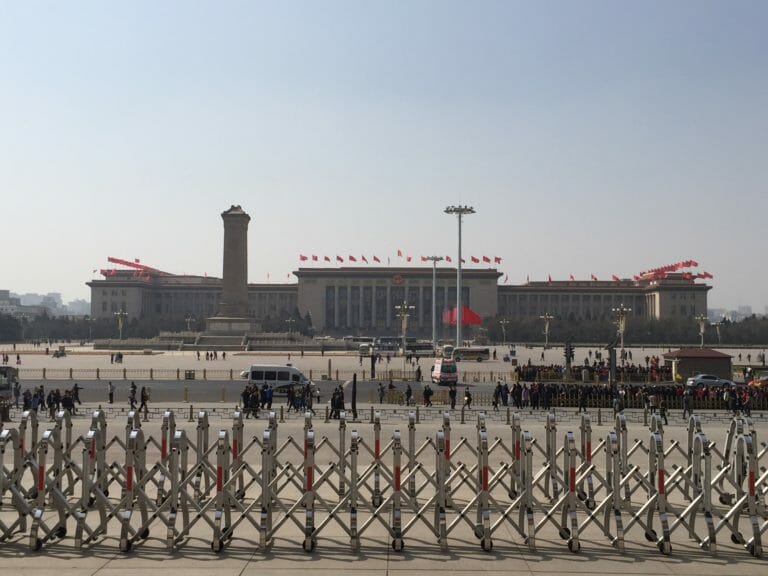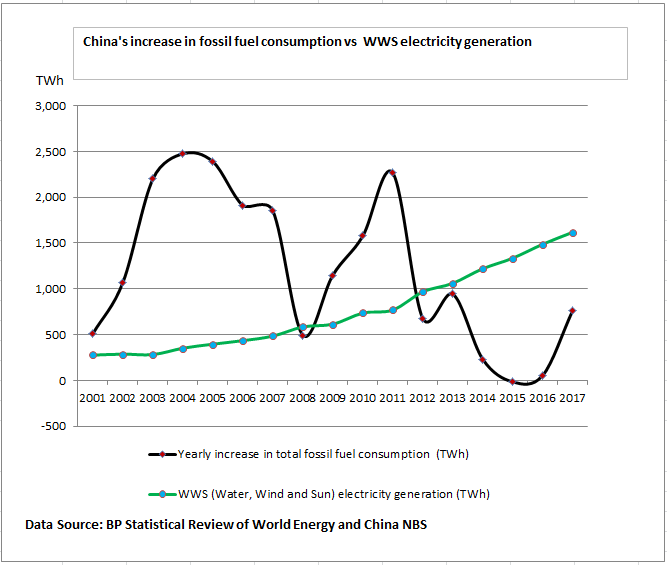China’s Green Shift Positions It to Overtake U.S. in Energy, Security
The country's turn to wind and solar is not only to protect the environment, although the Chinese government faced increasing urban protests if it did not clean up the air. The Great Hall of the People in Beijing, China. (Juan Cole / Informed Content)
The Great Hall of the People in Beijing, China. (Juan Cole / Informed Content)
The Guardian reports that air pollution in 62 Chinese cities fell by 30 percent between 2013 and 2016, according to the World Health Organization. Beijing, the capital, fell from a global fourth-place ranking on polluted air to 187th.
I was in Beijing in March 2015 for a conference, and did a jaunt out to the Great Wall, bringing my camera. I needn’t have bothered. That day, at least, you couldn’t see more than 50 feet away from your face, and my dreams of photographs of the wall stretching out into the distance were dashed. I was there for a week and my throat got sore from just breathing the air. Things are quickly improving, though. The smog in those 62 cities was largely being caused by burning coal, for household heating and industrial purposes. Coal is the worst emitter of carbon dioxide among the hydrocarbon fuels, but it also puts out, when you burn it, lots of particulate matter that causes lung problems, heart attacks, mercury poisoning and cancer.
Last year, the concentration of PM2.5, or tiny motes of particulate matter smaller than 2.5 microns, which can lodge in the lungs, was down about 40 percent in greater Beijing, compared with 2012.
China’s coal use has fallen enormously as a proportion of its electricity generation. It used to provide 80 percent of China’s electricity, but that is down to 65 percent and falling rapidly as a proportion. Even in absolute terms, despite a minor uptick in 2017, coal use has been declining since 2013.
A recent Brookings study by Wenjuan Dong and Ye Qi says,
- “In 2017, renewable energy encompassed 36.6% of China’s total installed electric power capacity, and 26.4% of total power generation. According to Energy Production and Consumption Revolution Strategy 2016-2030, by 2030, 50% of total electric power generation will be from non-fossil energy sources, including nuclear and renewable energy.”
These are astonishing statistics for one of the world’s two largest economies.
Although nuclear energy remains important, most new electricity generation in China in the past six years has come from renewables, according to a just-published paper by John A. Matthews with Xin Huang in the Asia-Pacific Journal that a friend sent me this morning.
This is its key chart:

Matthews argues that massive Chinese adoption of solar panels is the major cause for the rapid decline in their price since 2012, and that this price drop will continue. Likewise, he argues that for all the hype about China building new nuclear plants, it has in fact put most of its eggs with regard to new energy generation in the wind power basket.
New solar power bids are now being occasionally let for less than 3 cents a kilowatt hour. Coal is at least 5 cents a kilowatt hour, if you don’t count its environmental damage. If you take that into account, it is likely closer to 80 cents a kilowatt hour. With regard to China, the Brookings study notes, “In the most recently concluded Third Photovoltaic venture base bidding in China, the bid price for electricity continuously came in new lows. For example, the last two bids for cities Golmud and Delingha, both in Qinghai, came in at 0.31 RMB per kWh, which is even lower than the 0.3247 RMB per kWh price for on-grid desulfurized coal-fired electricity.” Even today, Chinese solar is cheaper than coal, and the competitive advantage of solar will only increase over the next decade.
Matthews further makes an important set of arguments about China’s green shift and global power. By generating its own electricity through renewables and by switching in a big way to electric cars, China is preparing for a vast reduction in its imports of hydrocarbons. In turn, that move makes China less vulnerable to hydrocarbon blackmail or blockade and increases its energy security.
The United States uses about 20 million barrels of petroleum a day. Despite the new production enabled by hydraulic fracturing, its own oil production is about half that. Some oil produced in the U.S., especially in Alaska and the West, can be more cheaply exported abroad than sent to the East Coast where the demand is. You see pundits and Big Oil propagandists hype U.S. production and U.S. exports, but the fact is that the U.S. still imports nearly half of the oil it needs to run its economy, and some of those imports come from unstable places like Saudi Arabia and Venezuela. On transportation (the major use of petroleum), the U.S. is highly vulnerable.
China put 680,000 electric vehicles on the road last year, and plans to be doing 2 million a year by 2020. These EVs will increasingly be fueled by renewable energy, reducing Chinese dependence on Saudi Arabia and Iran.
The turn to wind and solar is thus not only about the environment (though the Chinese government was increasingly facing urban protests if it did not clean up the air and switch from coal). It is also about energy security and the forging of new industries in which China can show its technological innovation chops. It can leverage its huge size and huge economy to become an invulnerable leader on energy and transportation, permanently replacing Detroit and Exxon Mobil.
Trump’s America, in contrast, is wallowing in a 20th-century hydrocarbon past, fast becoming a polluted, economic and technological dinosaur whose Department of Environmental Protection has been highjacked by a corrupt Oklahoma oilman for the purpose of running the country into the ground while Big Oil wrings every last penny from its pitiful stranded asset.
Your support matters…Independent journalism is under threat and overshadowed by heavily funded mainstream media.
You can help level the playing field. Become a member.
Your tax-deductible contribution keeps us digging beneath the headlines to give you thought-provoking, investigative reporting and analysis that unearths what's really happening- without compromise.
Give today to support our courageous, independent journalists.




You need to be a supporter to comment.
There are currently no responses to this article.
Be the first to respond.